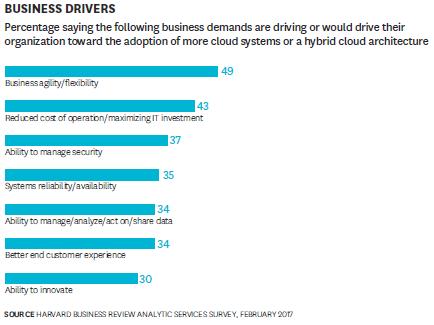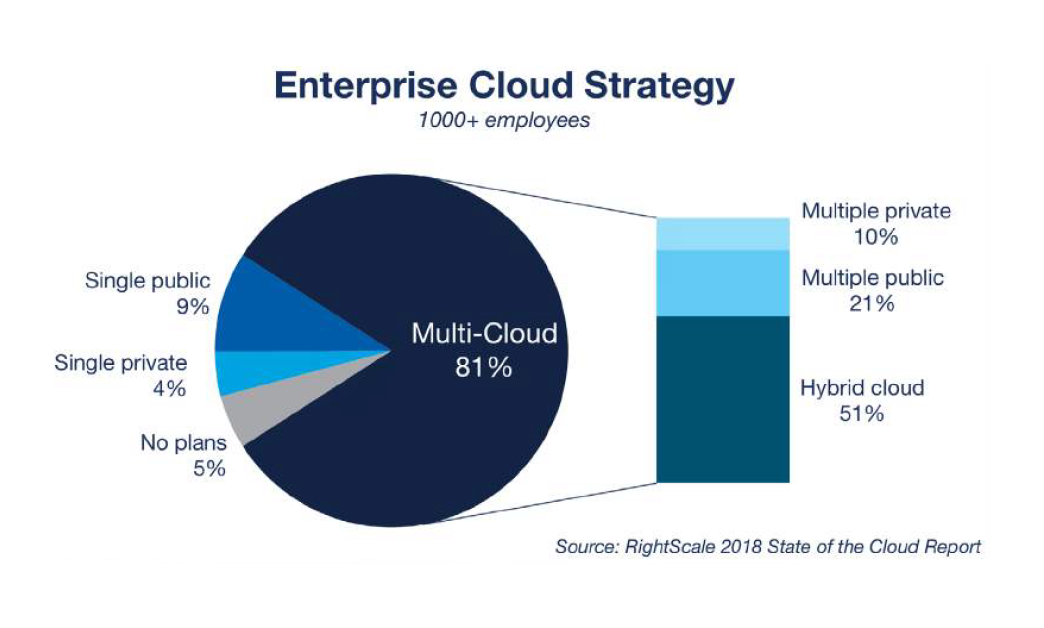Achieving Service Assurance across Multi-Cloud Environments
Assuring business services across changing, multi-cloud infrastructure offers businesses strategic advantages in flexibility and a better end-user experience.

Business leaders across virtually every industry now recognize that leveraging the cloud is essential to remain competitive. And according to a survey conducted by Harvard Business Review Analytic Services, cost efficiency is not the only advantage:

The ability to offer the flexible, high performance digital services that run on these cloud infrastructures, from customer engagement applications to internal operational services, drive today’s enterprise.
The perpetual quest for greater flexibility, better cost efficiencies and performance continues to generate more complex cloud configurations. Multi-cloud computing – which includes hybrid, federated, public and private cloud infrastructures – has become fundamental to providing these services:

https://www.rightscale.com/lp/state-of-the-cloud
It should come as no surprise that according to a global state of IT report, cloud computing ranked as the number one technology to have the most transformational impact on business – above artificial intelligence (AI) and mobile technologies for customers.
Increasing Complexity of Running Applications in the Cloud
Assuring the performance of business applications across multiple clouds is hampered by the complexity of run-time infrastructure and poor, actionable visibility. Nailing down the real source of a problem becomes difficult, time-consuming and problematic. Multiple vendors, from cloud vendors to application developers to WAN and ISPs, are certain the problem is not theirs. Point solution tools rule out potential areas of disruption rather than pin-point the true source.
The evolution of application code itself contributes to this challenge. Business applications built with micro-services distribute workloads to disparate combinations of on-premise, private and multiple public clouds, in fact frequently beyond your control, e.g. SasS services. Business applications also often rely on opaque, third party services, e.g. payment functions on a website. It becomes difficult to spot poorly written applications or isolate precisely where an application is struggling. Increasing network traffic, micro-services and this inter-connectedness can quickly introduce hard to pinpoint load and latency problems or communication issues that result in degraded application performance.
The Price of Complexity: Application Assurance
More complex, multi-cloud and hybrid infrastructure alone may or may not introduce problems running applications – but it certainly makes it much harder to monitor, let alone pin-point the root-cause of application failure and repair quickly (MTTR). Designed for byte code, server-centric applications, APM tools focus on inter-process communications within a server instance. Applications built on micro-services run independent, dynamic workloads across multi-cloud environments. The risks to critical business services escalate as organizations migrate more applications to multiple clouds, and the applications themselves become more interdependent via micro-services.
As the sheer scale, scope and reliance upon business applications grows, the burden on IT to assure services will only increase. Organizations will find it harder and harder to:
- Cost effectively deploy reliable applications across physical, virtual, hybrid and multi-cloud environments;
- Adequately monitor, and secure, critical business application performance, increasing risk to the business;
- Pinpoint/fix dynamic service-delivery bottlenecks, minimize disruption, and reduce (or maintain) MTTR to assure a higher quality end-user experience;
What is Needed?
Running applications on today’s infrastructures requires complete performance visibility across complex hybrid networks – a single view across physical, virtual and multi-cloud workloads. Application assurance means comprehensive visibility on the dependencies (introduced with distributed micro-services) throughout the path of service delivery (applications, protocols, elements, across campus, data centers, Internet, cloud providers, etc.). The best solution is a precise, cloud-agnostic view that does not discriminate between public, private or changing cloud environments, frequently third party and public.
Monitoring traffic in real-time, aka wire-data, is the best way to get a precise, line-of-sight view of application behavior, service dependencies, error details and true source of the root cause of failure. Wire-data is precise, portraying real-time behavior and consistent. Most importantly it is inclusive end-to-end: every application action and transaction must navigate the digital infrastructure – no matter physical, virtual, cloud or hybrid.
Given the volume of wire-data, automatic recognition of applications, protocols and other common elements will be required for ’smart’, actionable analysis. Smart analysis of wire data enables an in-depth understanding of application and system performance issues, independent of application source code and with no need for byte code instrumentation. Visibility that can empower real-time action requires the intelligent extraction and distillation of the most critical insights from the wire-data. Automatic, smart analysis of wire traffic is really the only source of precise, end-to-end visibility of application performance.
Successful Service Assurance across Complex, Hybrid Infrastructures
Healthcare Imaging Application Performance
Doctors at a leading healthcare provider of over 1,200 physicians and 15,000 full-time employees were waiting up to 20 minutes to view cardiology images from the radiology information system (RIS) application. The organization spent several weeks and daily “war room” calls that at times involved upward of 20 people – IT staff, third party vendors, and the application provider – trying to pinpoint the source of the problem. The deployment of the vSTREAM virtual appliance monitoring wire-data provided Adaptive Service Intelligence™ (ASI) and quickly pin-pointed the root cause of the problem to a mistake in the radiology application that sent recent images to a cloud storage service. Once the application was re-written to store recent images in the private, campus-based cloud, cardiac image retrieval times were reduced from 20 minutes to seconds.
Customer Application Quality Assurance
A multi-national hospitality corporation hosts millions of travelers at a broad portfolio of lodging and hotel facilities in over 120 countries – quality customer experiences are the life-blood of the business. After a recent acquisition, the IT team faced the challenge of providing service assurance for the website, inventory application, credit card authorization system, and frequent buyer programs across two different data center environments. By deploying vSCOUT on the web application servers IT was able to reduce complexity, and uncover service dependencies across application, compute and network workloads. IT reduced mean-time-to-repair (MTTR) for network issues, protecting millions in potential revenue for the business as well as ensure the highest quality customer experience.
Migrating Industrial Health & Safety Applications
An international pipeline and power company with over 15,000 employees and 3.5M retail customers is required to adhere to multiple safety and compliance guidelines. “Always-on” digital services are at the hearth of their health and safety systems, putting IT under significant pressure in protecting employees – let alone face stiff regulatory fines and penalties. Moving these systems to a hybrid cloud required performance assurance before, during and after the migration. IT implemented the nGeniusONE Service Assurance platform, powered by Adaptive Service Intelligence™ (ASI), to provide end-to-end troubleshooting across the hybrid cloud, ending time-wasting finger-pointing, better collaboration with third-party vendors to resolve issues quickly, and maintain health and safety compliance.
The Strategic Advantages of Assured Business Services
The adoption of hybrid, multi-cloud infrastructure has become a business imperative, not only for cost efficiencies. Assuring business services across changing, multi-cloud infrastructure offers businesses strategic advantages in flexibility and a better end-user experience. Seamless application performance delivering a superior end-user experience requires operating increasingly critical applications flawlessly across public, private and conventional infrastructure. True service assurance means going beyond byte code instrumentation to using smart data for system-level telemetry, providing the situational awareness to run everything reliably and confidently on hybrid cloud or multi-cloud infrastructure.